|
The
Wellhead Gardens
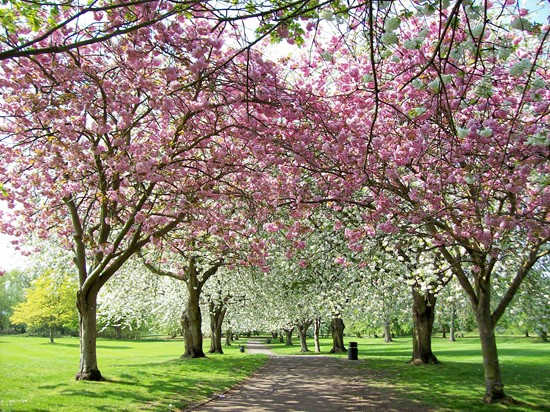
One of the most attractive places in Bourne
is the Wellhead Gardens, just a short step from the town centre but a place of peace and tranquillity favoured by walkers and office workers enjoying a sandwich lunch.
The 21 acres of meadow which included the Wellhead Fields and Baldock's Paddock were bought from the Marquess of Exeter and developed in the years following the Second World War as parkland open to the public.
The purchase was enabled under the terms of a bequest from local landowner and
farmer Alderman Thomas Whyment Atkinson (1874-1954) who left property at Haconby to the trustees to provide income for this purpose, together with the War Memorial
and surrounding gardens. This bequest continues to benefit the town today as the
Thomas Whyment Atkinson Charity and is still administered by Bourne United
Charities.
A notice at the entrance to the Wellhead Gardens states: "These private grounds are made available to the public by the Trustees of the Bourne United Charities. The Trustees invite the co-operation of all who enter the grounds to keep them in a clean and tidy condition so as to preserve the environmental qualities for the benefit of all. In the interests of safety, the Trustees do not allow the playing or practising of golf on any of these grounds. No responsibility can be accepted by the Trustees for any injuries caused by anyone disregarding this notice."
The public gardens are a particular delight when the cherry blossom makes its
appearance. White and pink flowering cherry trees that line the main path form a
colourful avenue for visitors and many walk the path and then, enchanted by the
sight, retrace their steps to take another look. Towards the end of April, the
petals fall and float down from the branches like snowflakes in winter, a
reminder of the fable of an Icelandic princess who married a Portuguese prince
and went to live in his country but missed the sight of falling snow and so he
planted an avenue of cherry trees to please her because each year when their
blossoms fell, they would simulate the scene she knew so well.
Another avenue in the park, to the north east and leading to West Street, is lined with horse chestnut trees that bloom with a mass of red candles during
May. This tree is a hybrid between our own native horse chestnut and the American red buckeye and is widely planted throughout Britain as an ornamental species and reaches a height in excess of 60 feet and is a favourite for planting in public gardens and alongside roads.
The graceful weeping willows (Salix x 'Chrysocoma') are among the most characteristic of our English landscape, especially near water where they can grow to heights of 65 feet. They can however, choke drains, dry out the surrounding area and even threaten the foundations of buildings if planted in suburban gardens but here on the river bank in a public park, the damp soil provides the perfect environment where their long and slender yellow branches covered with brilliant green leaves cascade over the water, providing a colourful display in springtime and hanging like silken drapes gently brushing on the surface.
One
of the most attractive seasons in the Wellhead Gardens is autumn when the
leaves fall and strew the grass beneath with a rainbow of russet shades,
of gold and brown, dark red and yellow, and provide a reminder that the
cold and the snow of winter is not far away.
Winter in the Wellhead Gardens can be equally attractive even though this is the time of year when the days are at their shortest and coldest, when there is little colour in the countryside and few signs of life from the animals that inhabit this place unless we have a layer of snow to reveal their tracks. Our trees, however, are conspicuous in winter, often more so than in summer, because visibility is less obscured by leaves and so their identification from silhouettes, bark or twigs can be a fascinating pastime. The flowering cherries stand stark against the grey January sky but we must remember the glorious colour their white and pink blossom will produce come April.
Before the land was turned into a park, it was known as the Wellhead Field and was frequently used by the town on public occasions. When the Crimean War ended during the 19th century, Bourne celebrated the restoration of peace on Thursday 29th May 1856 by the suspension of all public business at midday and then after the men were given a
dinner and a quart of ale and the women a high tea in the market place, there was a procession to the Wellhead Field for sports and a distribution of buns to children followed by a fireworks display from 9.30 pm to 11 pm.
An old stone property that can be found in the park, nestling behind high hedges, dates back to the 18th century and was formerly part of the Castle Farm, built in the local style with a Collyweston slate roof and rubble and limestone walls. It is now owned by Bourne United Charities and rented as a private home to suitable tenants and is known appropriately as the Wellhead Cottage. Its aspect presents such a peaceful scene that it is difficult to believe the hustle and bustle of the town centre is just a few paces away.
Grassy mounds in the park also remind us that this place contains the earliest traces of a settlement in Bourne and may have been the site of successive Saxon and Norman
fortifications while the Shippon Barn nearby is reputed to have been constructed
from the remains of the last old castle and is now used by the guide and scout
organisations.
In 2012, the gardens were extended by four acres
with the creation of the Jubilee Meadow to commemorate the Diamond Jubilee of
Queen Elizabeth II that year. The new grassed area contains footpaths mown into
a cross and surrounded by a profusion of wild flowers which were specially sown
while trees were planted at each corner, the entire layout designed to attract
more wildlife.
A commemorative oak tree was also planted in the centre of the meadow to mark
the jubilee during a ceremony on Wednesday 16th May 2012 by the Mayor of Bourne,
Councillor Brenda Johnson, with Trevor Hollinshead, chairman of the trustees,
Bourne United Charities, and Councillor Helen Powell, deputy mayor. Other town
councillors and trustees of BUC also attended the ceremony.
|
SOME FEATURES OF THE WELLHEAD
AND WAR MEMORIAL GARDENS |
|
 |
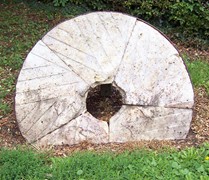 |
|
Seats are situated at various points around the gardens for the
benefit of visitors but in past years they have been vandalised and
graffiti scrawled across the slats which were often prized away from
the frame. The design of the rubbish bins that stood alongside was also inadequate with the
result that the contents often spilled through the metal slats and were
scattered by the wind. In January 2009, replacements for both were installed
by Bourne United Charities, a total of seven seats and eight bins,
all designed for more efficient use and built with special materials to
ensure a longer and damage free life.
A short distance from the South Street entrance is an old iron-rimmed millstone embedded in the earth as a reminder of the six water mills that once operated
along the Bourne Eau and are mentioned in the Domesday Book of
1086. Three survived until recent times but only one remains, Baldock's Mill on the very edge of the Wellhead Gardens, although this millstone is most likely to have come from one of the other two, either Notley's
or Cliffe's Mill, now both demolished. |
|
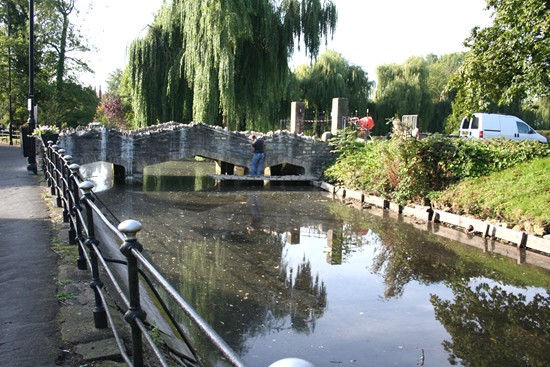 |
|
One of the most attractive spots in the town is
the stone bridge across the Bourne Eau in South Street, built as an
approach to the War Memorial gardens when they were established in
1956 and still a magnet for anyone wanting to take a photograph,
especially newly-weds after tying the knot at the Abbey Church
across the road. It has withstood the weather well over the past
half a century but finally succumbed to the severe frosts during the
winter of 2009-10 which damaged the pointing stones on the top,
leaving many chipped and broken. Bourne United Charities who are
responsible for the gardens, employed a stonemason to carry out
remedial work during September 2010 which involved chiselling
replacement sections from blocks of stone and he did a fine job to
ensure that the bridge remains intact as a picturesque feature in
this part of town and as the backdrop for photographers for many
years to come. |
|
TREES
TOPPLED BY GALES
|
|
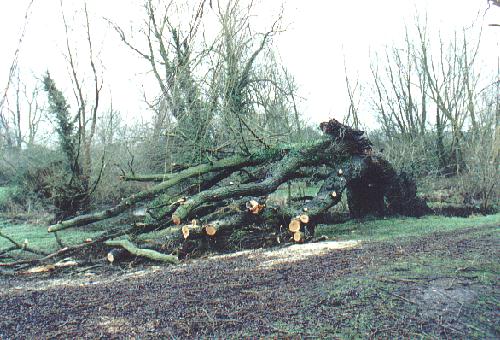 |
|
High winds during January 2001 removed some familiar landmarks from the Wellhead Gardens. Two willow trees that have been standing for half a century were rent asunder by a southerly gale and thirteen others were badly damaged.
One of the trees beside St Peter's Pool was a particular loss because it was the largest to be seen on the skyline by visitors entering the park from South Street and was planted soon after the Second World War.
Some of it was
subsequently sawn into logs by park staff and given away as firewood although willow spits when burned and is therefore more suitable for wood burning stoves rather than open fires. But
the trunk and main branches remained and soon became a play
attraction for children and despite the danger, no attempt was
made to move it and it was still there eight years later (see
picture below).
The second tree stood on the banks of the Bourne Eau near to its source and was equally ancient but the damage it sustained demonstrated the strength of the gale because its massive trunk was split down the middle and its main branches toppled. The loss of favourite trees from a familiar landscape is a poignant reminder of the forces of nature which, at their most extreme, can do just as much damage as man unchecked. We must therefore be forever vigilant about what we have left and think twice before we even trample a blade of grass.
|
|
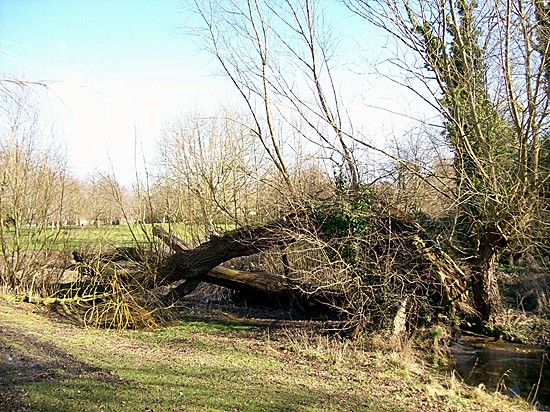 |
|
MAINTENANCE OF THE GARDENS |
|
 |
|
Maintenance of the Wellhead Gardens was improved with
the purchase in March 2010 of a state of the art tractor unit, 40 h p,
four-wheel drive and capable of a variety of tasks that hitherto had been
labour intensive and therefore time consuming. The new vehicle, pictured
here with park manager Andrew Scotney and assistant, also has a flail
fitting for dykes and hedges, a mower attachment, front loading bucket,
leaf collector and all purpose trailer, and is therefore capable of most
seasonal tasks. |
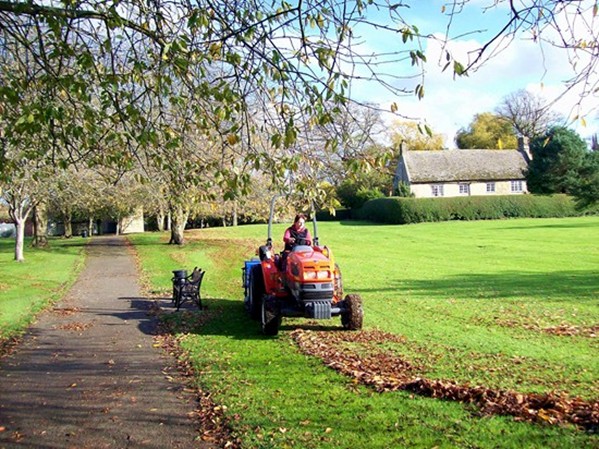 |
|
FROM THE ARCHIVES |
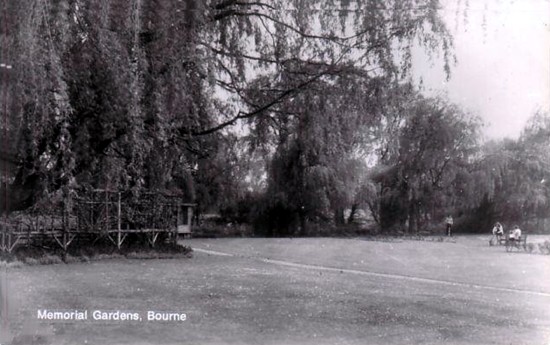 |
|
A postcard view of the War Memorial Gardens
soon
after they were opened in 1956. |
REVISED SEPTEMBER 2014
See also
The Wellhead
play area

Go to:
Main Index Villages
Index
|







